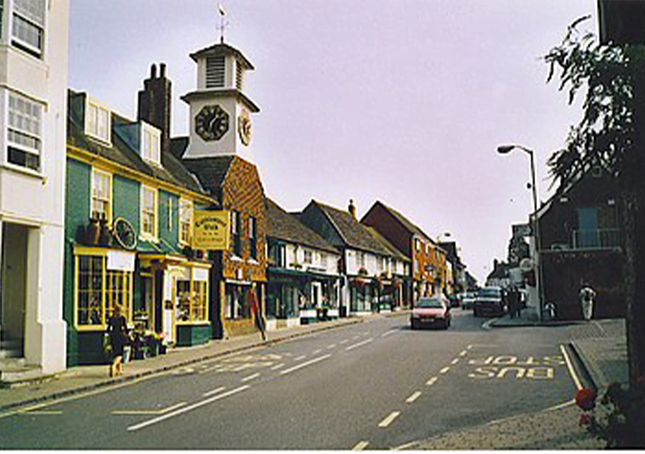Steyning

Steyning (/ˈstɛnɪŋ/ STEN-ing) is a small rural town and civil parish in the Horsham District of West Sussex, England. It is located at the north end of the River Adur gap in the South Downs, four miles (6.4 km) north of the coastal town of Shoreham-by-Sea.
The smaller villages of Bramber and Upper Beeding constitute, with Steyning, a built-up area at this crossing-point of the river.
The parish has a land area of 1,574 hectares (3,890 acres). In the 2001 census 5,812 people lived in 2,530 households, of whom 2,747 were economically active.
Saxon
Steyning has existed since Anglo-Saxon times. Legend has it that St Cuthman built a church, at one time dedicated to him, later to St Andrew, and now jointly to St Andrew and St Cuthman, where he stopped after carrying his mother in a wheelbarrow. Several of the signs that can be seen on entering Steyning bear an image of his feat. King Alfred the Great’s father, Æthelwulf of Wessex, was originally buried in that church, before being transferred to Winchester – a Saxon grave slab (possibly his) remains in the church porch.
Norman
To thank his Norman protectors for refuge during his exile, Edward the Confessor granted his royal minster church in Steyning, with its large and wealthy manor lands, to the Abbey Church of the Holy Trinity at Fécamp, to take effect after the death of Aelfwine, the Bishop of Winchester, who had charge of Steyning. The bishop died in 1047 and ecclesiastical jurisdiction then passed directly to the Pope. (In the same way, Fécamp Abbey itself answered to no Norman bishop, only to the Pope.) This was confirmed in a charter by William. Confirming the gift of Steyning, made by Edward the Confessor, this charter acquitted the grantees of all earthly service and subjection to barons, princes and others, and gave them all royal liberties, custom and justice over all matters arising in their land, and threatened any who should infringe these liberties with an amercement of £100 of gold.[4] This was an addition to the nearby port with land around Rye, Winchelsea and Hastings, already given to the same Abbey by King Cnut, to honour a promise made by his wife Emma of Normandy’s first husband King Aethelred. By then Steyning was already a thriving and important port with a market, a royal mint, the church founded by St Cuthman and one other church, as Domesday Book relates 60 years later. Godwin, Earl of Wessex expelled the Norman monks in 1052 and seized Steyning for himself, and his son Harold decided to keep it upon his accession. This made commercial and strategic sense as Harold did not want a Norman toehold in a potential invasion port, but William responded by swearing on a knife before setting out for England to recover it for the monks:
Of the land of Steyning [county of Sussex]; the Duke gave seisin to the Church by the token of a knife, before he went to England; the grant to take effect if God should give him victory in England.
Witnesses: Aymeri the vicomte; Richard fitzGilbert; Pons.
This gained him a ship from Fécamp and, upon his victory at Hastings, he honoured his promise and returned it to the monks. However, its strategic importance made William place William de Braose in a new castle at nearby Bramber, who began a vigorous boundary dispute and power tussle with the monks, William’s settlement having lacked definite terms in the first place. Domesday Book, completed in 1086, brought this to a head. It found that de Braose had built a bridge at Bramber and demanded tolls from ships travelling further along the river to the port at Steyning. The monks challenged Bramber’s right to bury its parishioners in the churchyard at William de Braose’s new church of St Nicholas, and demanded its burial fees, despite it being built to serve the castle not the town. The monks produced forged documents to defend their position and were unhappy with the failure of their claim on Hastings.[6] In 1086 the king called his sons, barons and bishops to court (the last time an English king presided personally, with his full court, to decide a matter of law) to settle this. It took a full day, and the Abbey won over the court, forcing de Braose to curtail his bridge tolls, give up various encroachments onto the abbey’s lands[7] and organise a mass exhumation and transfer of all Bramber’s dead to the churchyard of Saint Cuthman’s Church in Steyning.
